Author: Jason Cipriani
Adding coffee to beer seems to have become fairly common practice over the last few years, with breweries dosing styles ranging from Blonde Ale to Stout with the roasty bean. Given its characteristic similarities to certain dark grains, coffee is usually the feature ingredient in so-called White Stout. I think it’s safe to say the use of coffee in brewing is here to stay, particularly during the colder months when darker beers are in season.
There are a few approaches to using coffee when brewing beer, all of which have their proponents and opponents. While one can certainly introduce coffee at some point during the actual brewing process, such as adding grounds during the mash or boil, it seems most brewers prefer dosing the beer with a volume of brewed coffee post-fermentation.
One of these approaches involves adding coffee made using hot water to the beer once fermentation is complete, simply brew up the appropriate amount of your favorite java and toss it into the beer. Quick and easy, this method has received some criticism from those who believe the hot steep extracts certain compounds that impart harsh characteristics to beer. For these folks, the ideal method involves letting the grounds steep in cool water over a long period of time, which is said to extract a smoother, more robust coffee character.
I rather enjoy coffee beers but haven’t brewed many myself, hence my curiosity as to whether or not hot or cold steeping actually made a difference. What better way to find out than to put it to the test!
| PURPOSE |
To evaluate the differences between Coffee Stouts made with either hot or cold brewed coffee and otherwise treated identically.
| METHODS |
In order to highlight the differences as much as possible, I stuck to a simple American Stout recipe.
Manic
Recipe Details
| Batch Size | Boil Time | IBU | SRM | Est. OG | Est. FG | ABV |
|---|---|---|---|---|---|---|
| 6 gal | 60 min | 40.7 IBUs | 40.6 SRM | 1.049 | 1.013 | 4.8 % |
| Actuals | 1.049 | 1.011 | 5.0 % | |||
Fermentables
| Name | Amount | % |
|---|---|---|
| Pale Malt (2 Row) US | 11 lbs | 89.8 |
| Roasted Barley | 1.25 lbs | 10.2 |
Hops
| Name | Amount | Time | Use | Form | Alpha % |
|---|---|---|---|---|---|
| Magnum | 21 g | 60 min | Boil | Pellet | 14.5 |
| Hersbrucker | 14 g | 30 min | Boil | Pellet | 2.2 |
| Hersbrucker | 21 g | 10 min | Boil | Pellet | 2.2 |
Yeast
| Name | Lab | Attenuation | Temperature |
|---|---|---|---|
| Flagship (A07) | Imperial Yeast | 75% | 60°F - 72°F |
Notes
| Water Profile: Ca 52 | Mg 9 | Na 37 | SO4 34 | Cl 44 |
Download
| Download this recipe's BeerXML file |
I started my brew day by collecting 2 identical volumes of RO water and adjusting each to the same desired profile– the Grainfather being a 5 gallon brewing system, I brewed 2 batches side-by-side and staggered the start time by 30 minutes. While my strike water was heating, I weighed out and milled the grain.
After mashing in, I checked to ensure both mashes were at the same target temperature.
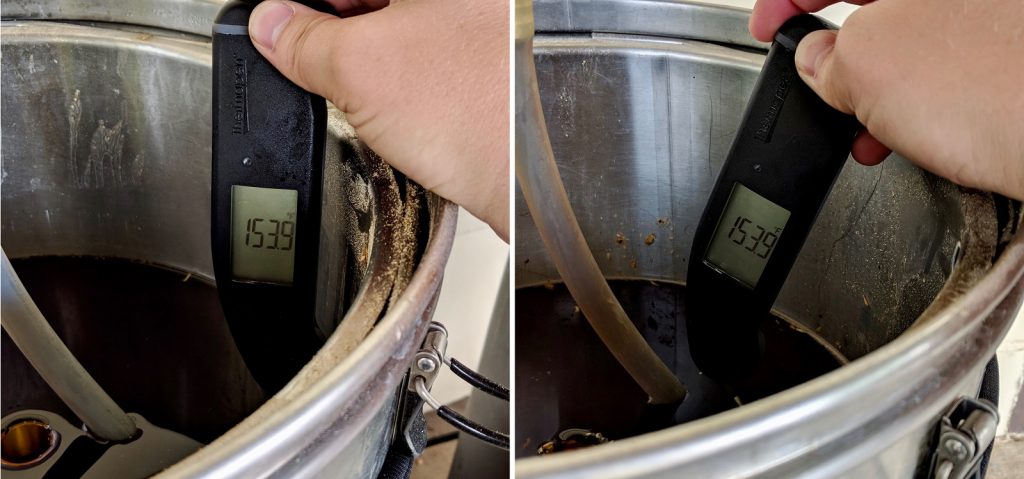
I took a pH readings 15 minutes into each mash that showed, unsurprisingly, they were both at what the Bru’n Water Spreadsheet predicted. Someone forgot to snap a pic of the second batch…
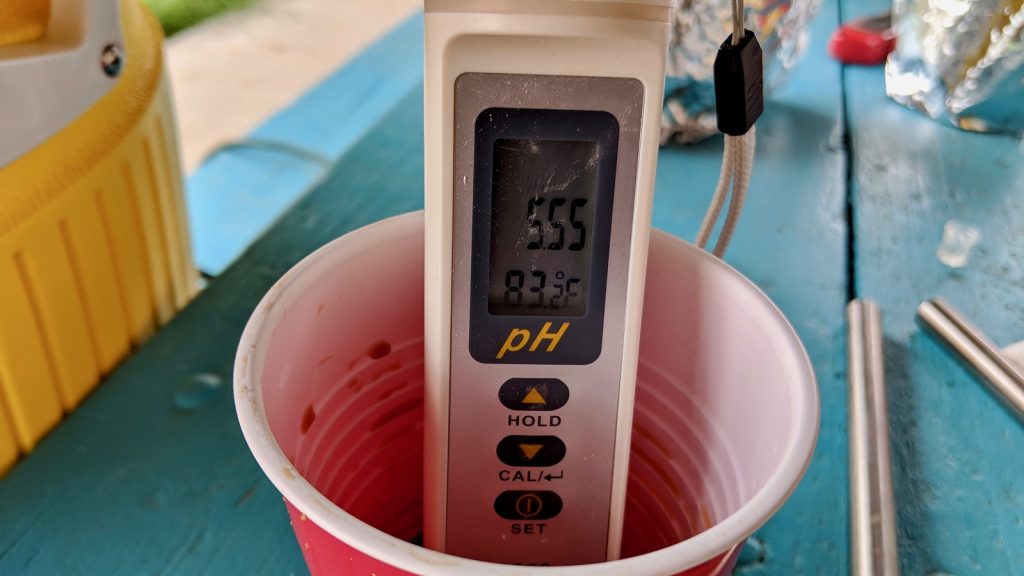
While the mashes were mashing, I used my heat stick to heat the sparge water.
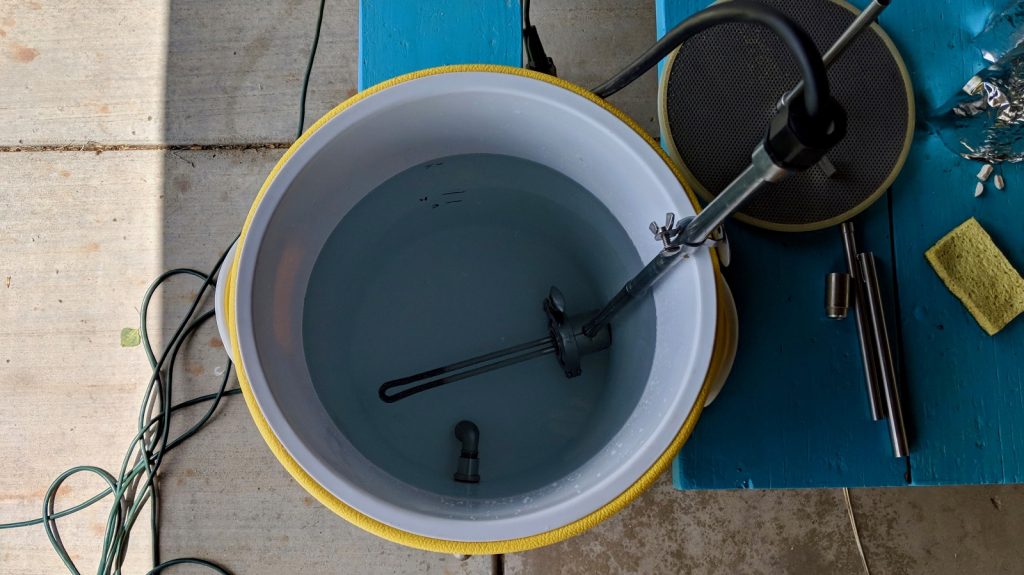
With about 15 minutes left for the first batch, both mashes were maintaining the set temperature.
Each batch was subsequently sparged with equal amounts of hot water, after which I turned the Grainfather elements on full blast. While the wort was heating, I measured out the kettle hops for both batches.
When the boils were finished, I chilled and transferred each batch to identical fermentation vessels.
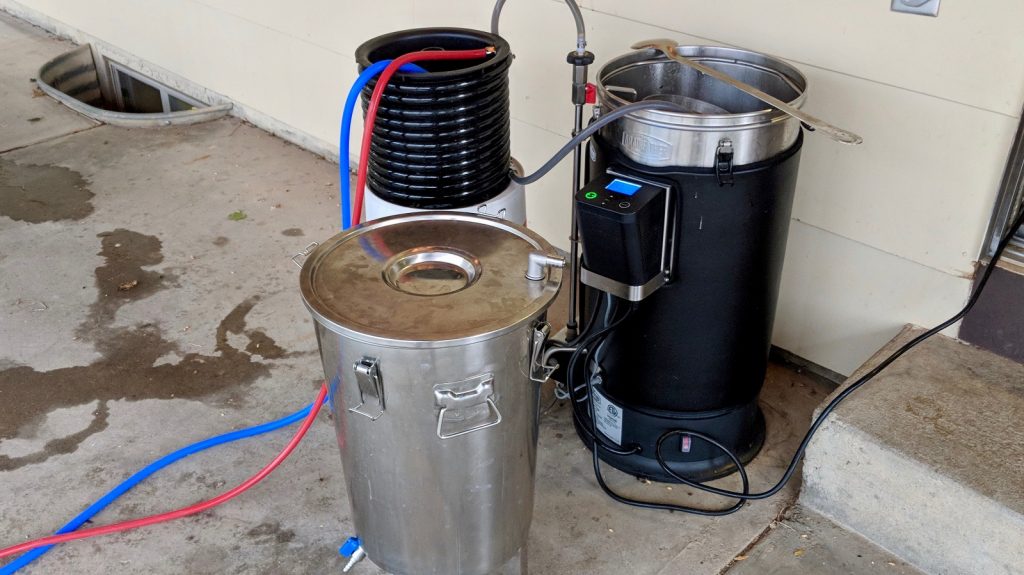
Hydrometer measurements revealed both worts had reached the same OG.
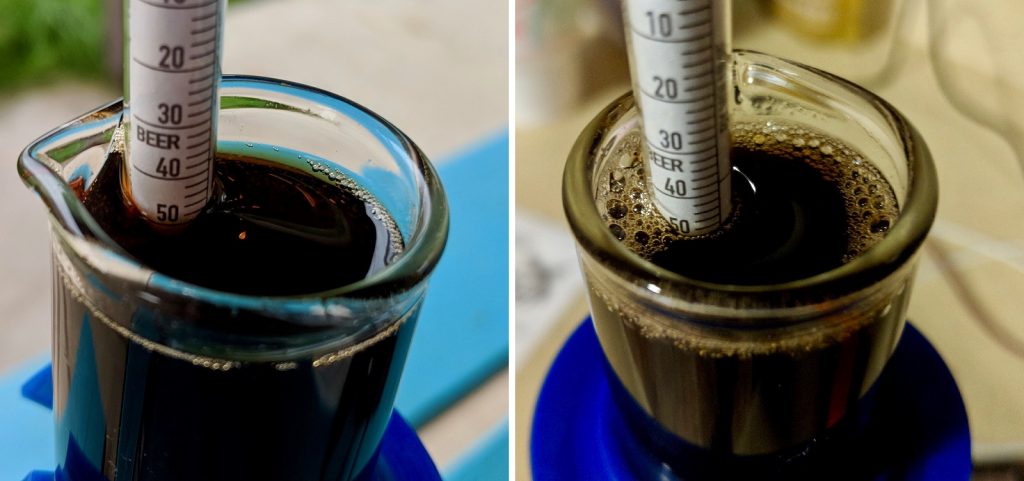
I placed the fermentors next to each other in my chamber and left them alone to finish chilling to my desired fermentation temperature. At this point, I stole some leftover wort and made a single vitality starter using Imperial Yeast A07 Flagship.
A few hours later, I pitched equal amounts of the starter into either batch then let them ferment at 66°F/19°C for a week, at which point neither was showing signs of activity. Hydrometer measurements confirmed both had attenuated to the same target FG.
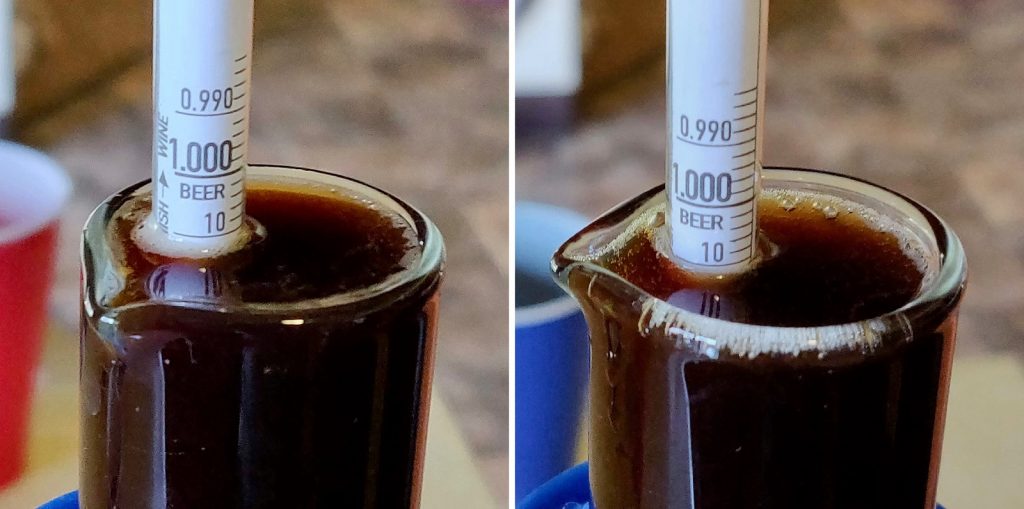
The time had finally come to introduce the variable. I made the cold brew coffee by combining 6 oz/170 g of freshly ground beans in 30 fl oz/0.9 L of water and letting it steep in my refrigerator for 18 hours. The liquid was then strained to remove any coffee grounds and I ultimately ended up with 24 fl oz/0.71 L of cold brew coffee.
Just prior to kegging, I used identical amounts of water and beans to make 24 oz/0.71 L of hot coffee using an Aeropress.
The differently brewed coffees were added to separate sanitized kegs before packaging commenced.
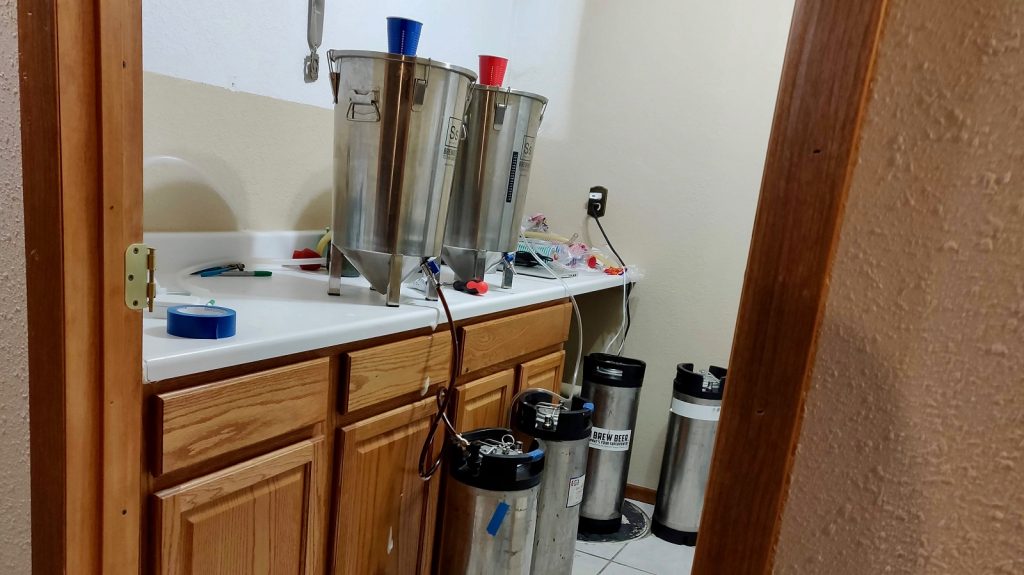
The kegs were placed in my keezer where they were cold crashed and burst carbonated. After a week of conditioning, I began serving them to unsuspecting tasters.
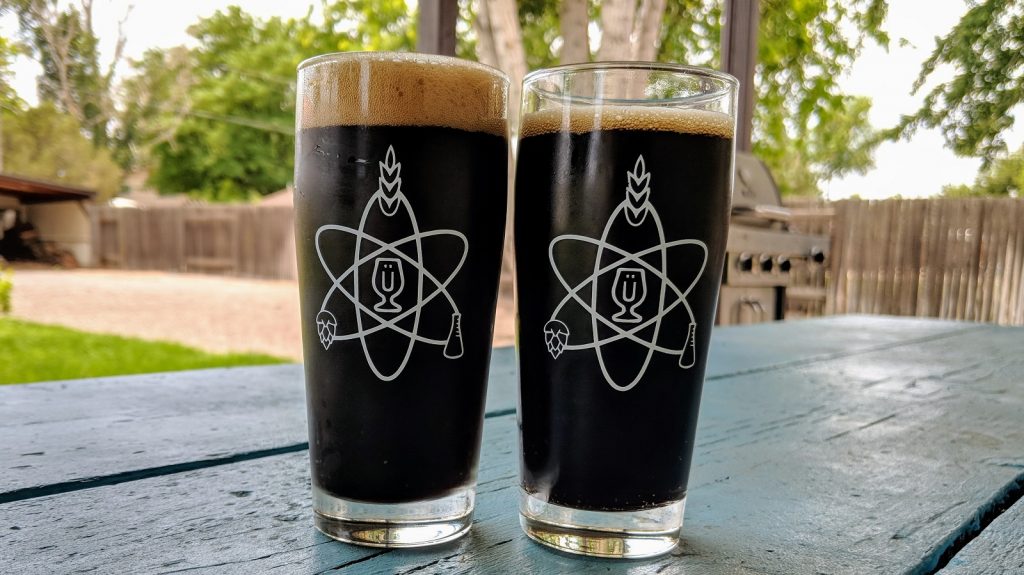
| RESULTS |
A total of 20 people of varying levels of experience participated in this xBmt. Each participant was served 2 samples of the hot brew coffee beer and 1 sample of the cold brew coffee beer in different colored opaque cups then asked to identify the unique sample. At this sample size, 11 tasters (p<0.05) would have had to identify the unique sample in order to reach statistical significance, though only 5 (p=0.85) made the correct selection, indicating participants in this xBmt could not reliably distinguish a Coffee Stout made with hot brew coffee from one made with cold brew coffee.
My Impressions: When I first started sampling, I felt the cold brew coffee beer had an ever-so-slightly sharper bitterness to it compared to the hot brew coffee version. The difference wasn’t nearly as drastic as I assumed it was going to be, which showed in my blind triangle test performance– out of 10 attempts, I was only correct 5 times. As for the beer itself, the taster I trust the most, my wife, said it was the best Coffee Stout I’ve made to date. Roasty and malty with the coffee character rounding things out to create supreme balance. I will absolutely be brewing this recipe again soon!
| DISCUSSION |
There are some interesting methodological similarities when it comes to brewing coffee and beer. Just as serious beer brewers focus on specific mash temperatures, quality-minded baristas consider water temperature for every cup they brew. Whether one chooses a hot brew method to extract roasty and acidic characteristics or a cold brew method to produce a sweeter, more robust cup, the choice of organic coffee beans might also significantly influence the flavor and quality of the final product.
With the growing popularity of coffee beers, brewers have been forced to consider the impact coffee brew method has on their beer, with many opting for the cold brew approach in hopes of creating a smoother product with more coffee flavor. Given the drastically different temperatures and steeping times, as well as the myriad reports of either technique creating a distinguishable product, I was a bit shocked that tasters in this xBmt were unable to reliably distinguish the hot brew coffee Stout from the one made with cold brew coffee.
I’ve consumed my fair share of both hot and cold brew coffee, methods I’m convinced produced different flavors, hence my admitted conviction those differences would carryover to the finished beers. This isn’t brewlosophy (tm tm tm), so I neither collected data on the coffee itself nor attempted triangle tests on them myself, though after this experience, I’m very interested to look more into it. And I definitely plan to continue exploring the way different methods of using coffee in brewing impact beer.
If you have any thoughts about this xBmt, please do not hesitate to share in the comments section below!
Support Brülosophy In Style!
All designs are available in various colors and sizes on Amazon!
Follow Brülosophy on:
FACEBOOK | TWITTER | INSTAGRAM
If you enjoy this stuff and feel compelled to support Brulosophy.com, please check out the Support page for details on how you can very easily do so. Thanks!

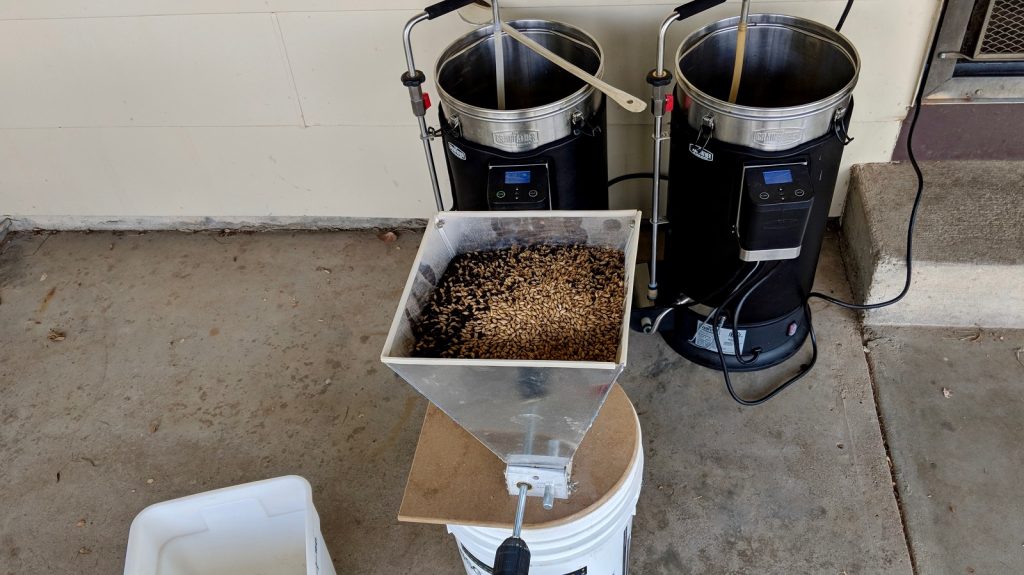
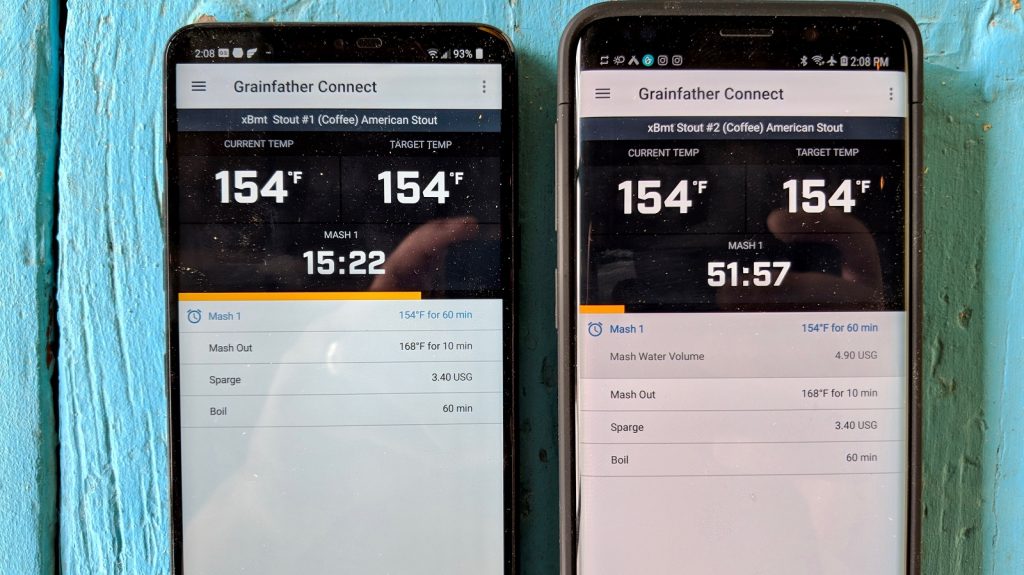
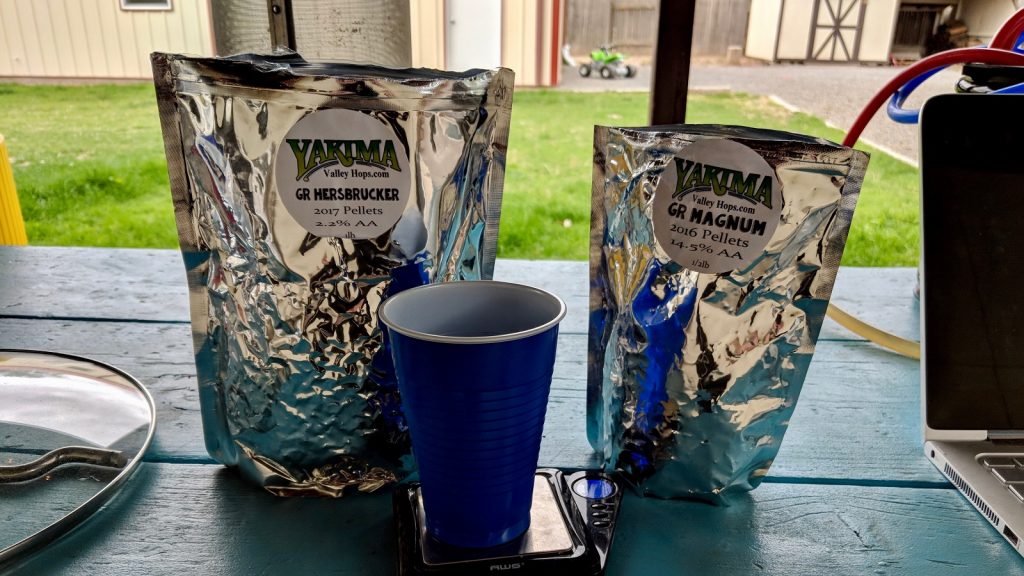
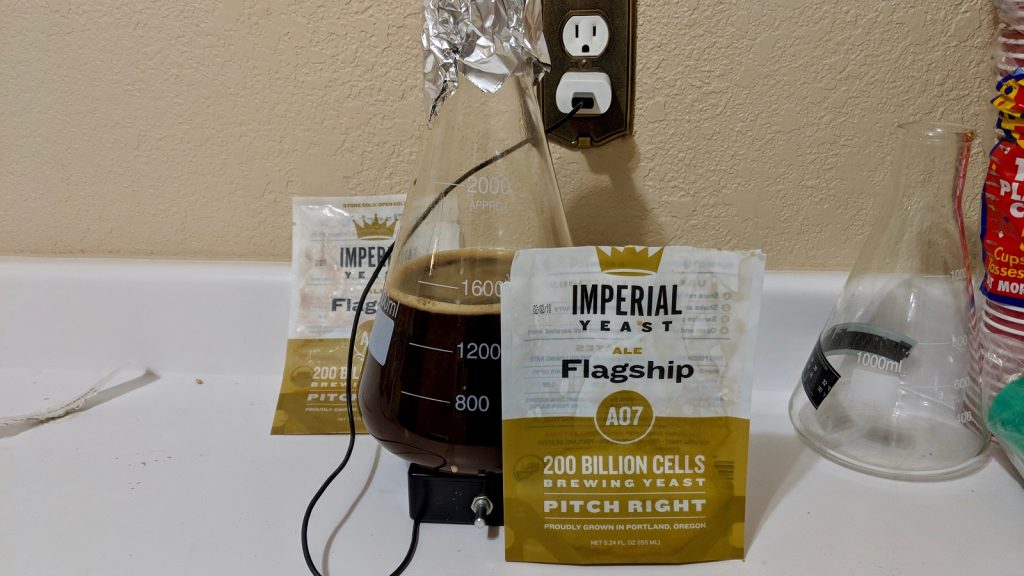
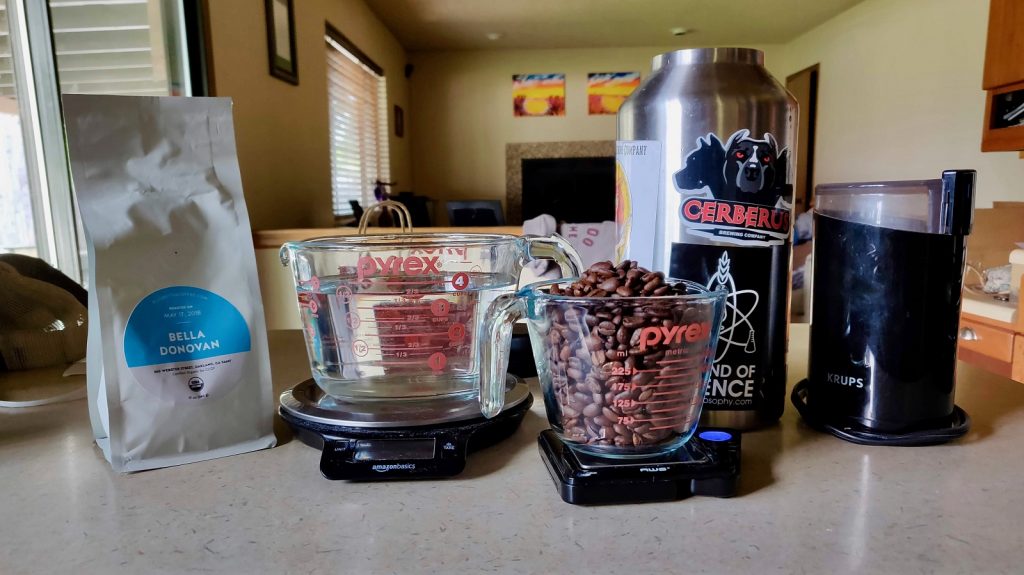











31 thoughts on “exBEERiment | Brewing With Coffee: Hot vs. Cold Brew In An American Stout”
Brewing good coffee is about as complex as brewing good beer. One of the main difference is that coffee have an extraction sweet spot. (below that it will be too sour, above it it will be too bitter to put it in simplistic terms but this assumes that you won’t use over roasted coffee) Depending on extraction time the longest hot method I have ever seen is still below 5 minutes with a filter roast and filter grind and the water is somewhere between 85-95 Celsius. This shows that we can’t just put our coffee in the boil because we would over extract them.
If you hit a similar extraction yield in your hot brew and in your cold brew those should taste the same in the beer if the water to coffee weight ratio was the same. (on their own they should taste a bit different because near boiling water extracts a bit different stuff from the bean than cold)
Hitting the same EY with two different methods like these needs a lot of practice and knowledge, (and most of all measurement) similar to the difficulty of brewing the same beer in your garage and then in a brewery.
My own advice would be brewing a proper coffee with whatever method and adding it at kegging/bottling time.
Three cups of coffee in 5 gallons of beer means there’s about a tablespoon of coffee in each 12 oz pour. It’s not surprising tasters couldn’t distinguish these beers given the small fraction of coffee in them.
I haven’t brewed with coffee yet, but if this is the typical amount used, then I suppose the subtlety of hot vs cold brew will always be insignificant.
I think the point of the cold brew method is that you’d use double the amount of coffee in the same volume of water to extract a more intense liquid without the bitterness that you’d get if you were hot steeping. This allows you to pack more coffee flavor in each oz of liquid.
The volume of coffee might have been three cups, but be sure to note that he used 170 grams of coffee in those three cups. If I were to make 3 cups of coffee for enjoyment right now, I would be using about 66 or so grams of coffee.
If you want to think about it in terms of volume of brewed coffee present in each pour, you need to consider the water to coffee ratio. Typical brewed coffee is around 15:1. This is basically a 3X concentrate with a ratio of 5.3:1. Thinking about it this way, there’s 1.5-2oz of typical strength brewed coffee in each 12oz pour – certainly enough to taste. That being said, I’m still not surprised it wasn’t enough to be significant in a coffee stout which has some pretty strong flavor for the coffee to contend with.
I did miss that, as I was too lazy to convert grams to more familiar ounces.
Thanks for pointing this out, Brian and Sean!
I’ll second this. A lot of Xbrmnts will reduce other variables as much as possible (like having a simple grist), but they will push the tested variable towards the extreme, to help see if there really is a difference. I recommend you read the following blog about determining correct dosing for homebrews, as it was cowritten by a pro brewer and a barista: https://fifthseasongardening.com/coffee-porters
Nice write up. What about skipping the coffee brewing (and the water it would add) and just adding the beans (crack, crushed, or ground) to the fermenter after primary fermentation?
Definitely a common method and something I hope we test in the future!
That would be like making a cold brew which extracts for days or weeks depending on how fast you empty that keg. There is a reason most coldbrew recipes are limited to around 12 hours.
Could you get around that by just cracking beans instead of grinding to limit (slow down) the extraction? I have heard on people doing this but haven’t tried it myself.
Other people have steered you in the right direction: The reason we don’t add beans directly is loss of control and over extraction. Doing a brew and adding the liquid allows you to dial it in beforehand! I always try to make a little more cold brew than I think I’ll need, so I can keep adding more and more until I like the way the blend tastes.
My favorite way of introducing coffee to beer is to cold-brew… but with beer instead of water. I used my French Press, filled with about 8 tablespoons of rough ground, locally roasted beans (I equate 1 TBS to 1 cup of joe) with as much post-fermented beer that’ll fit. Let it sit for 36 hours, add to the keg, then force-carb.
I like this idea, as it won’t affect your ABV% . Good idea!
Ditto Lee’s comment about the dilution of the coffee (to less than 5%), which of course vastly dilutes any difference between the 2 coffee brews. Also, in a stout, the coffee is up against a lot of heavy flavour, with lots to get lost in. In a blonde ale or a lager, it might be more obvious. When you consider the method of adding the coffee at kegging, it does raise the question of why bother making your whole batch coffee brewed ? If you simply added 1/2 – 1 oz (or more if you like) of good brewed coffee to your beer when you pour it, you can make it to suit your own taste, so that everyone can have it the way they like it. Commercial brewers can’t do that, but it’s another advantage of home brewing. Of course there’s nothing to stop you from throwing an oz or so of coffee into a Heineken or Guinness either. The idea of mixing beer with flavouring at the time of serving introduces all kinds of options. Will the day come when you order or pour a beer and add a shot of extra Citra extract and 2 shots of Saaz ?
If there is a demand for more variety then it will come. The shot of extract comment does make me cringe a bit though. I compare it to the coke freestyle machines. I love having all these options but I can certainly taste the difference between a freestyle pour and the same bottled drink. I do also see a lot more direct coffee additions coming with the rise in nitro coffee’s popularity along with all the coffee and brewery hybrids opening.
I cringed when I wrote it, but I also cringe at the idea of a Shandy, or beer and grapefruit, lemonade etc. that are being marketed these days. But, to each their own.
Hot water doesn’t make a coffee instantly bitter, over extraction makes a coffee bitter. It is true however that you can easier over extract coffee with hot water due to the faster extraction times.
Like here is an aeropress recipe which works for me with filter roasted beans and AP filter grind.
300g water, 87 celsius, RO water + 50ppm magnesium
17g coffee
100s steeping time (i start the plunge about 30s from the end)
i only mix the coffee during the pour with two mves and then dont disturb it
(my grinder was set up for this method, its a filter grind much coarser than the particle size you get with pre ground (a big nono) supermarket coffees so you wont be able to replicate this without a grinder but having a grinder is about as important and mandatory for coffee as having a mash tun or fridge for beer)
By the way no one does a coffee sensory test with a blade grinder, they are pretty much “banned” as a grinder due to the extreme variance of particle size. (from dust to huge chunks of bean) This means you pretty much can’t get a good extraction with them because the dust will over extract and the boulders will under extract and you will get a mess of a coffee. One of the favoruite grinder in the industry is the Mahlkönig EK43 and it is mostly because it’s particle distribution is one of the most uniform in the bussiness.
By the way the common coffee we got used to in the restaurants, gas stations, pod machines, Starbucks etc. is about as bad as BMC in beer or even worse in someways. Getting into good coffee is a really similar experience as getting into good beer. They can even enhance each other. (for example the knowledge i got from water adjusting and water recipe calculating during homebrewing gave me a big advantage over most baristas and also a lot of the tools are good for both like the scales, thermometers etc.)
Strictly using roasted grains and not coffee (I will have to try it sometime) I used to add them to the mash for the final 30 minutes but switched over to cold steeping, exclusively. For me, it’s easier to grind the roasted malt the night before, steep it in the fridge for 12 to 16 hours in distilled water at a pH of 5.2, and then add the resulting liquid at flameout. The flavor and aroma are strong but tend to mellow the longer the beer is kegged.
Nice writeup.
Wonder if there would be more difference with a blonde coffee beer, where the coffee is not competing with a roasted grain. I love me some of those, but HWMO is pretty much a big NO on anything coffee. Might have to do just a gallon for me from a bigger batch….
I’m a bit surprised anyone could taste the coffee in the cold-brewed version. Cold brew should be made at room temp, not in the refrigerator. The fridge significantly slows the extraction and produces a “green” tasting drink with weak coffee flavor. The other factor to consider is grind size. Too fine a grind will affect your extraction- the longer the steep, the courser the grind. If you used a blade grinder, the particles were likely all different sizes, resulting in an uneven extraction.
Always YOU give us an open mind way and for brewing and for life
Thank you so much
Did the tasters (especially your wife) express a preference?
She did not. To her, these were identical beers.
Any consideration for doing a similar batch with more beans / concentrated flavor? My coffee stouts use a lot more bean and less liquid, with the impact being very noticeable.
I am definitely a coffee, beer, and coffee beer fan. One thing that I have noticed in homebrewed and commercial coffee beers is that you sometimes get the coffee grounds flavor that I do not like. I believe that is through the over-extraction that can occur with either hot or cold brew processes (grind level, water temp, and contact time imbalance). I have also notice that if you age that same beer with over-extracted coffee, the coffee ground flavor will transition to a peppery/green pepper flavor after several months. With that in mind, perhaps you could take these same two beers, age them 6 months, and then retry the triangle taste to see if the two methods have any discernable impacts on favor stability. If you try it, I would love to hear the results.
I would be concerned about oxygen in the coffee liquid oxidising the beer. Is this not a thing? Previously I’ve added coffee grounds with the yeast to avoid this.
I like to do it a completely different way.
I found the best way for me was to do it the way the brewery (that I used to work for) did it.
After primary fermentation is complete and just before bottling… (or kegging)
1) take a 1/3 of the beer and transfer it on top of a mesh bag of fresh ground coffee (I usually do this in the bottling bucket).
2) Let it sit for 48 hours.
3) Remove the coffee bag.
4) Then transfer the remaining volume of beer to the bottling bucket to recombine it.
5) Bottle as usual.
Note:
A) If you are kegging then do all of the above in a keg.
B) if you have the means, cover with a blanket of co2.
I recently had the opportunity to brew with a very unique coffee. I walked into Veteran owned Mountain Air Coffee Roasters and saw a Balcones Bourbon barrel sitting on the counter. I told the owner that I’m a homebrewer and I know what I’D do with that barrel, but what’s HE doing with that barrel? Turns out he puts green Sumatra beans in the barrel for about 3 months before roasting them. The result is a beautiful, delicate, bourbon infused cuppa. I told him I wanted to make a beer with his coffee and offered to trade beans for beer, which he jumped at. At first I was thinking a stout or Porter, but really wanted to showcase the flavor of this coffee, so I decided on a pale ale made with Warrior and Centennial since the guy’s a vet. Here’s where I get to the point 😁
I had planned on making a cold brew but when I posted on HBT someone pointed out that any brewed coffee would water down the beer and suggested that I just “dry bean” the beer by putting the coarse ground beans in a bag (I BIAB and Wilserbrewer tossed a few extra hop bags in my last order), toss them in the fermenter, and check regularly until the desired level of coffee flavor is achieved. I think the beer turned out great…not something you want to drink several of but a great beer to sip with a nice cigar!
I’d love to see a coffee experiment with cold brew vs dry bean in a beer that can showcase the flavor a little more. Maybe I’ll send a bottle in for a review and see how many JerseyTims it gets!
Interesting article! I enjoy to read it. But I sure I am not to do this stuff. I am a big coffee drinker, and I expense more money for coffee. I also bought the burr grinder for the perfect cup of coffee from https://chocolatemachineinfo.com/best-coffee-grinder-for-cold-brew/, and it gives the excellent result. I feel relaxing and better to drink this burr coffee from the coffee grinder.
Many thanks. This is a useful post.